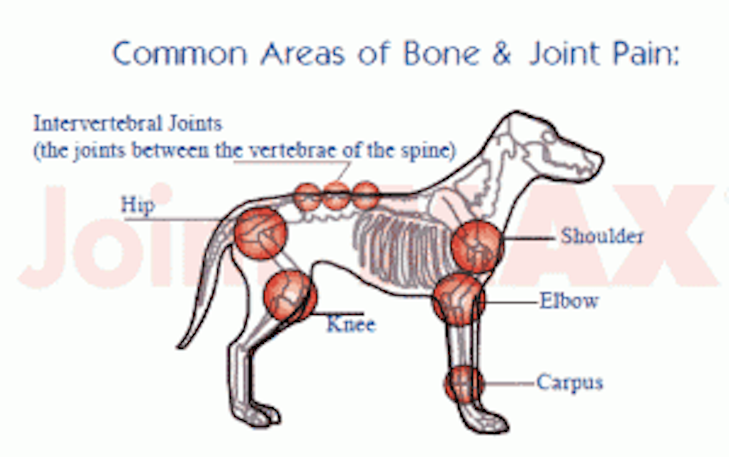Clubs Offering:
Many dogs suffer from arthritis as they age. This painful condition, which occurs in dogs and people, results when cartilage, the cushioning between the bones, begins to thin and wear away. As a result, the ends of the bones start to rub against each other, and you may notice your dog starting to limp. Trauma, disease, or normal wear and tear that comes with use over years all may cause arthritis.
“While there is no cure for canine arthritis, some treatments can lessen pain and improve mobility,” says Dr. Jerry Klein, the AKC’s chief veterinary officer.
Glucosamine, a naturally occurring compound, is one of the more popular over-the-counter arthritis remedies. It is one of several natural substances, or nutraceuticals, that are known as chondroprotective agents, used in the treatment of arthritis in humans, dogs, horses, and other animals. In dogs, glucosamine is also often used to:
Glucosamine joint supplements are said to alleviate the symptoms of joint damage by boosting the repair of damaged cartilage, specifically articular cartilage, or the moist, spongy material that forms a cushion between joints. Joint supplements are often used as an early intervention and throughout the progression of arthritis, as they are safe for long-term use in most patients.

“Cartilage plays an important role, and when damaged, it won’t usually repair or duplicate itself on its own,” says Dr. Klein. “So the bones of the joint may rub against each other, causing pain and inflammation.”
Dr. Georg Ledderhose first identified glucosamine in 1876. Glucosamine is supplied in one of three forms: glucosamine sulfate, glucosamine hydrochloride, or N-acetylglucosamine. No one knows exactly what the mechanism of action is, but glucosamine, an amino sugar, appears to improve the synthesis of glycosaminoglycans, one of the building blocks of cartilage.
Glucosamine is often used in conjunction with another natural substance, chondroitin sulfate, which is also aimed at stimulating cartilage repair. Chondroitin is made from cow or pig cartilage and is also derived from the shells of crabs, oysters, and shrimp, or synthesized from plant sources in laboratories.
The U.S. Food & Drug Administration (FDA) regulates these products as dietary supplements, not drugs, and as such, they are not subjected to the same stringent FDA review and approval process as pharmaceuticals. Dietary supplements are evaluated for safety after they are on the market, mostly through “adverse event monitoring.” Glucosamine has been used in veterinary practices in Europe and the U.S. for about 20 years.
Starting in the 1980s, scientists began investigating glucosamine and chondroitin to try to prove whether they work, but so far, there is still not a common consensus, and studies in humans have been inconclusive.
In 2012, an examination of studies in humans found that one form — glucosamine hydrochloride — had little effect, while another form — glucosamine sulfate — offered pain relief superior or equal to “the commonly used analgesic or non-steroidal anti-inflammatory drugs.” The scientists determined that “the question of the benefit of glucosamine treatment remains largely unanswered.” But, they noted that, because the supplements have “low and rare adverse effects, it represents a viable option for the management of osteoarthritis.” They also expressed the opinion that it could be useful in combination with drugs and other natural products.
Unfortunately, there’s little in the way of veterinary research thus far. In 2007, scientists at the College of Veterinary Medicine, University of Georgia, Athens, conducted a review of 16 clinical trials of treatments for osteoarthritis in dogs. They reported their results in the Journal of the American Veterinary Medical Association and found that preparations containing glucosamine provided a “moderate level” of comfort, and were on a par with some prescription drugs.

“Glucosamine and chondroitin are commonly recommended by veterinarians as an alternative for treating osteoarthritis in canines unable to tolerate the adverse effects of NSAIDs, or as add-on therapy,” concluded a February 2017 article in Open Veterinary Journal. “Although glucosamine and chondroitin have benign adverse effect profiles, the clinical benefit of using these agents remains questionable. Further study is required to clarify the uncertainty around the clinical benefit of using these agents and quantify any treatment effect that exists.”
There have been very few side effects observed in patients taking glucosamine, including:
What are the side effects of dog glucosamine?
Glucosamine in dogs has mild side effects, if any at all, because it’s a naturally occurring substance in the body. Possible side effects might include:
These side effects are brief and should go away after several doses. However, once you begin the nutraceutical treatment, carefully observe your dog for any perceptible changes in behavior to confirm there is no allergic reaction after the first dose. If you notice something that might be serious, such as difficulty breathing, stop serving immediately and go to a local animal hospital.
Make notes about how your canine reacts to the glucosamine treatment, making sure to include the dates and dosage amount. This method can help you gauge how well they’re responding to the supplement and if there’s anything you need to make your doctor aware of.
Pro Tip: If your dog needs emergency treatment because of a bad allergic reaction, you should know that it often comes with a huge bill. Thats where pet insurance proves its worth. With pet insurance, you can sleep tight knowing that you can efficiently deal with your pets emergencies.
Differences in Digestibility
Most human joint supplements consist of a pill you swallow, while dog supplements typically come in the form of a chewable tablet, soft chew, or liquid. This is no accident. Dogs have a shorter digestive system than we do, so the supplement needs to be broken down faster before it leaves their body. Chewable tablets, soft chews, and liquids all break down quickly, allowing your pup to readily absorb the nutrients and reap the benefits. If you were to give a dog a human joint pill to swallow, chances are it would pass through their system before it could be absorbed.
Using Glucosamine for Dogs
[vc_row][vc_column][vc_column_text]If you’re a human who has arthritis, you may notice that the first ingredient in your joint supplement is glucosamine. And if you have a dog with arthritis, you might have seen that the first ingredient in their joint supplement is, also, glucosamine. So this begs the question – what’s the difference?
The short answer is that while the main ingredient of glucosamine may be the same in most human and canine joint supplements, there are major differences between the rest of the ingredients, as well as the digestibility, dosage, and composition.